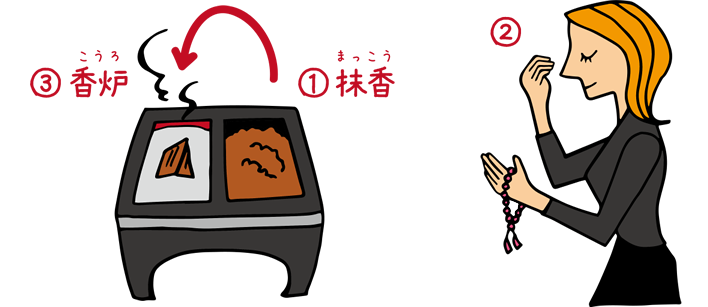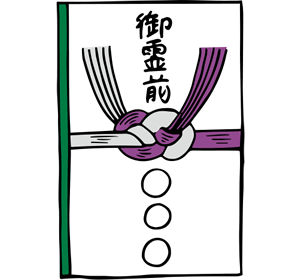Special Feature 「Japanese Culture that Amazes the World」Vol.1. Funeral Customs
03/25/2016 (mm/dd/yyyy)

Even after living in Japan for a long time, there are still things that foreigners have questions about. Please feel free to ask us for information about life in Japan.
|
This is information concerning Buddhist funerals, which are the most common type of funeral in Japan. Usually people attend the wake before the funeral, or the funeral. If you attend both, you must take a monetary offering (kouden), in a special type of envelope, bushuugifukuro, for funerals. Be careful not to use a shuugibukuro, as these are only used for celebrations such as weddings, births and entrance to school. A bushuugifukuro is white, with a black and white decoration. They are sold at convenience stores, 100yen stores and stationary shops. The envelope will have a slip of paper with 御霊前 goreizen, or 御仏前 gobutsuzen written on it. Use the envelope with 御霊前 written on it and write your name below it. Put money in the envelope and write the amount of money on the back of the envelope, in the bottom left corner. People usually give 3,000yen, unless you are close to the deceased, in which case 5,000yen is usually given. Make sure NOT to use mint, clean bills. |
|
|
|
Wear black clothing to the wake. Makeup should be kept to a minimum and no perfume or jewellery other than pearls should be worn. At a funeral, women must wear black tights, black shoes (enamel or shiny shoes should be avoided), and a black suit or dress. Short skirts, see-through materials, sequins or shiny materials should be avoided. Handbags should be black, plain and simple. Men should wear a black suit, black tie and black socks. |
|
|
When you arrive at the funeral or wake, write your name in the visitors book and hand over the bushuugifukuro envelope. Either at this time or when you leave, you will be given a kaisouonrei, acknowledgment gift. These are usually expendable a such as tea, sweets or detergent. There will also be a letter of thanks and some salt for purification. (Recently kaisouonrei are also known as koudengaeshi).
When you enter the hall, someone will guide you to your place. You will make an incense offering at the altar. Bow once to the priest and the family of the deceased, take a pinch of incense between your thumb and index finger, raise it to the level of your eyes, then drop it gently into the incense burner. After that put your hands together and offer a prayer to the deceased. Then bow once to the photo of the deceased and return to your seat. If you are not completely sure what to do, then watch what people around you do and copy their actions.

When talking, please do so in a quiet voice. The service usually finishes after an hour or so. Sometimes the koudengaeshi gift is sent separately to the acknowledgment of attendance letter, a few days later.
The customs for funerals may differ according to religion and region. If you are unsure about anything, please ask one of your Japanese acquaintances.
January 26th 2016 Takako Tomita

